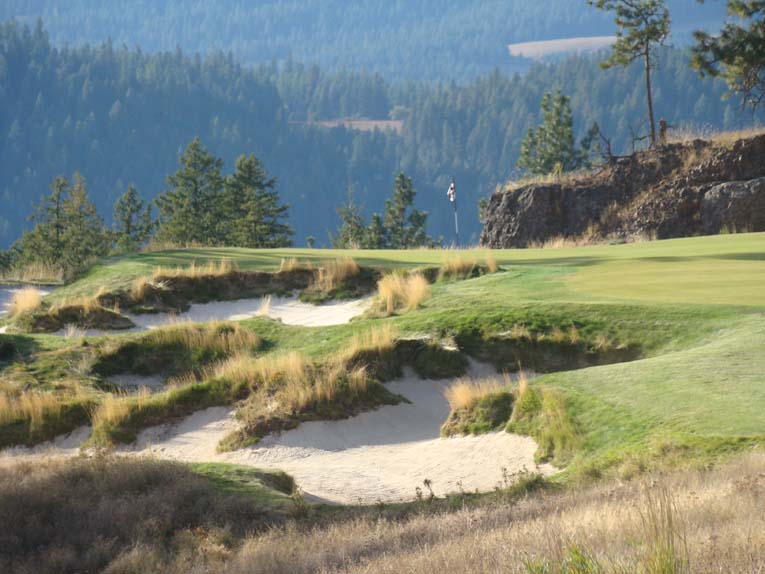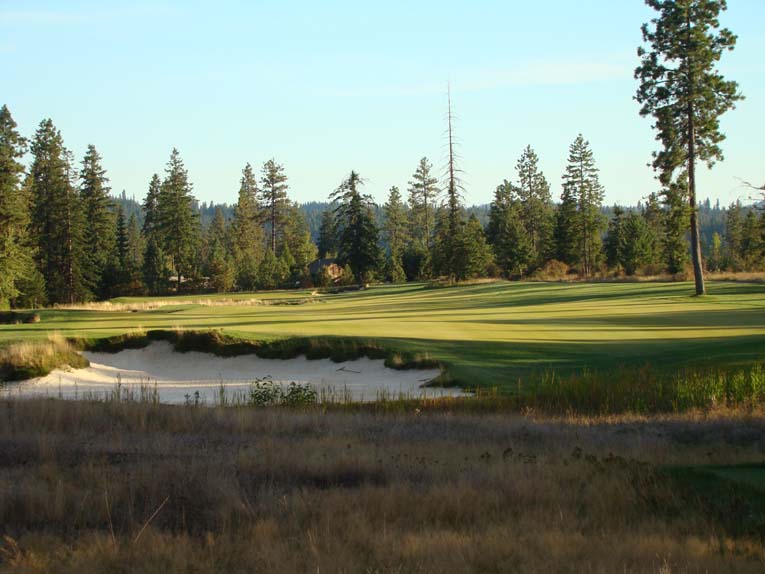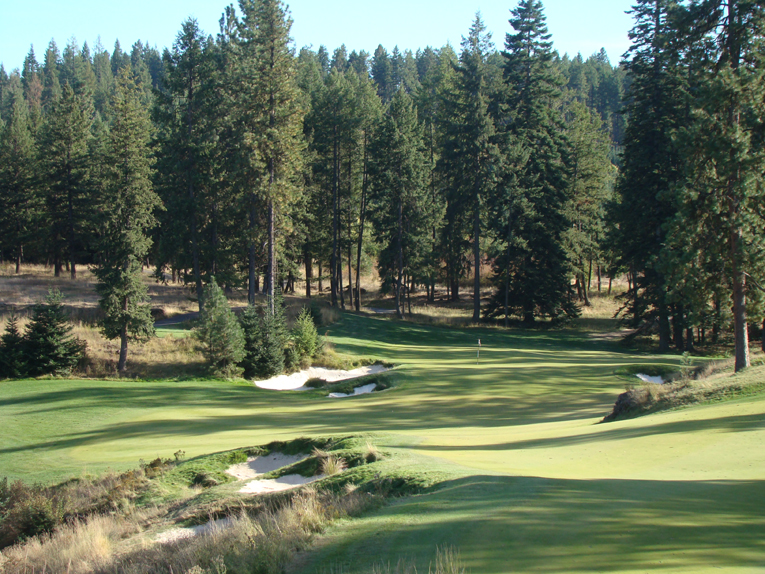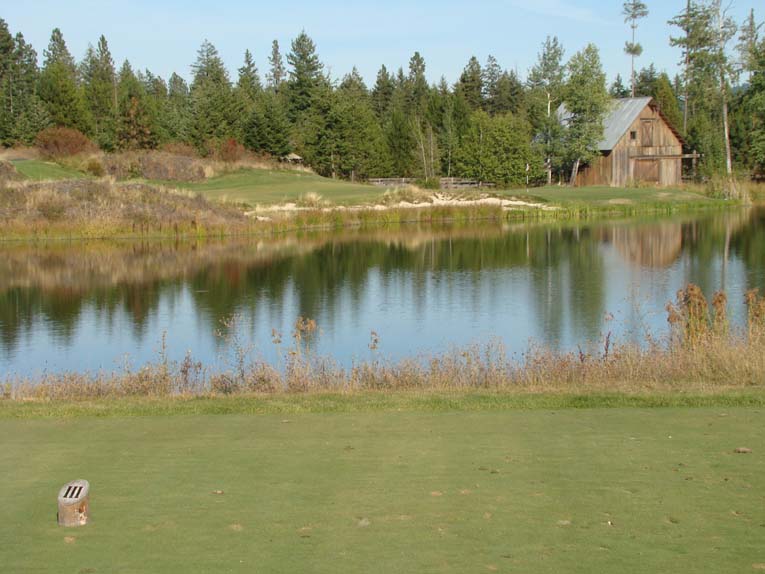Gozzer Ranch Golf and Lake Club
Idaho, United States of America
The game of golf had its inception on the shores of Scotland on land ill-suited for anything ”worthwhile.” The charms of seaside golf are obvious but the crucial feature of these elementary courses was the subsoil – sand – that imbued the game. The virtues of sandy soil for a golf course can not be overstated and whether it was happenstance or divine intervention where golf was first played it was sandy scrub that defined the game’s elements. Elsewhere in the world, a high percentage of land near large bodies of water is rocky. If golf had been invented in Maine, it might well be a very different game! Indeed, Golden Age architects had no way to work effectively in such conditions and for decades great golf was confined to a handful of ecosystems. Happily, modern construction techniques and greenkeeping practices have evolved so that sites once inhospitable for golf now aren’t. As these barriers fell, golf spread to many striking retreat spots including Patagonia, Baja California, and here in Coeur D’Alene, Idaho. In many ways, the Gozzer Ranch Golf and Lake Club epitomizes the strides made to provide compelling golf in new areas while duly reflecting the native surrounds.
The Gozzer story starts long ago, thousands (!) of years ago. The dominant physical feature, the very reason why a course would/should be built here, is the immense, sparkling Coeur D’Alene Lake that features nearly 110 miles of shoreline. Formed by floods over 10,000 years ago, the lake is measured in millenniums, not centuries. Nearly a century ago, the Gozzer family settled in Idaho and developed mining and ranching interests. Ultimately, in the 21st century, local rancher John Gozzer contributed 600 acres of his family’s land to this Discovery Land Company project. Mr. Gozzer was a man who loved the area, validated by his spending his entire 90 years here. From the low point of the property along the lake to the high point some 325 feet above, no one knew it better or cherished it more than Mr. Gozzer. Bald Eagles frequent the area and the wonders of that he would have enjoyed over decades are the stuff of dreams. Interestingly, when he passed in 2004, his estate (including the proceedings from this development) was donated to local charities since he had no heirs.

Details like the four inch lodge pole fencing that dots the property completes the frame. This particular section dates back decades.
Thematically, the course and club reflect the timeless allure of the region. Nothing is rushed or hurried. Even the most self-absorbed golfer realizes where he is and how minuscule his footprints are on this grand land. The laconic vibe that comes from waiting for wild turkeys to clear a tee or for a family of deer to pass does wonders to help all players slow down and decompress.
When Discovery commissioned Tom Fazio to proceed with the project, a vitally important requirement was made: all turfed areas would be sand capped. Given that trucks are restricted to 65 feet or less on the winding Coeur D’Alene lake road, importing sand was tedious, expensive and supremely worth it.
According to Green Keeper Jim Mcphilomy, who was present for the grow-in, the climate with its low humidity, cool evenings + the sandy soil makes Gozzer ‘a grass growing paradise.’ Mcphilomy is at greater liberty to stress the creeping bent fairways to achieve firm playing conditions. While situated in the Pacific Northwest, the northern half of Idaho enjoys a microclimate significantly different than the gray moist conditions associated with the Pacific coast. Many more days of sunshine swathe this area during the crucial summer and fall playing seasons.
From a design perspective, the favorable climate and sand capping enabled the Fazio organization to build features that hug the ground. Not every green had to be built up to shed water and some are sunken. Many are open in front and seamlessly tie into the fairway. Firm turf enables the course to play as well as it photographs. Fascinatingly, there isn’t a single catch basin on the course; everything surface drains just like the Golden Age courses.
Scott Hoffman, who headed the project for Fazio, focused on insuring that the course sported a 1930s feel. Bunker styles date courses so particular attention was paid to them here. Mcphilomy didn’t want maintained, hard edged bunkers and used sod knives and dry wall cutters to carve out bunker faces and create eyebrows. Though that work was laborious, the desired results were achieved and the bunkering handsomely mimics nature.
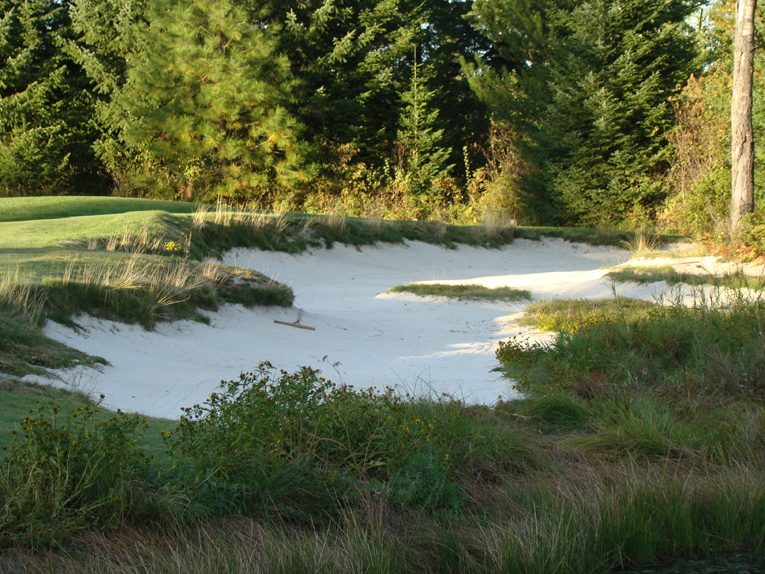
Fly mowers and string trimmers are now used during the season to help maintain and highlight the eroded bunker walls.
This is still rock country and some stone needed to be removed during course construction. Where dynamiting was necessary, the tie-ins and the resultant exposed walls remain in synch with their environs. Indeed, the author considers this to be one of Fazio’s least manufactured courses and is one that should pass the ‘test of time’ in exemplary fashion. That is important because the past three decades have demonstrated that manufactured courses typically come with a high annual maintenance fee. Not here, the design features snuggle into the landscape and the construction techniques set the stage for a happy, sustainable existence with conditions well suited for golf, as we see below.
Holes to Note
(Though the course stretches over 7,300 yards, the most fun for the 7 to 12 handicap golfer is found over the 6,550 yard course, a delightful combination of playing the II and III tees.)
Second hole, 545 yards; An initial routing had holes 2 through 5 play in the reverse direction (i.e. one would have played this hole as the fifth from near the green backwards and it would have been a par 4). There were some pros to that routing but this hole and the next highlight the cons! One now plays this long hole keenly aware of its alpine setting, as opposed to away from the inspiring peak of Spokane Mountain.
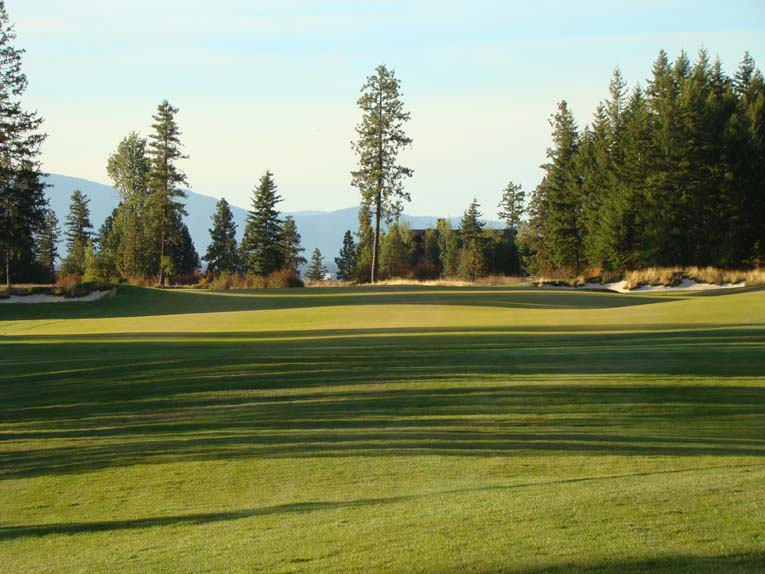
As seen from near the tee, what a delight to play a hole of this length early in the round that celebrates the glories of the course’s location.
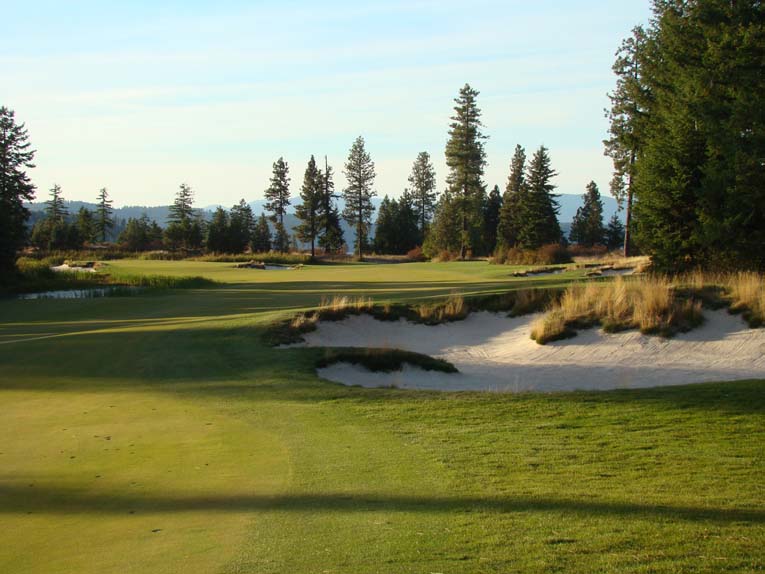
A lay-up some 90 yards short of the green near the natural wetland provides the best angle to most hole locations.
Third hole, 160 yards; The ultimate routing placed the third tee close to Lake Coeur D’Alene. The merits of doing so are undeniable and the benefits echo throughout the round. Back in the 1980s and 1990s when the best land wasn’t committed to golf, such a spot would likely have been a saved for the penultimate hole. At Gozzer, the two nines are well balanced with each offering diverse highs.
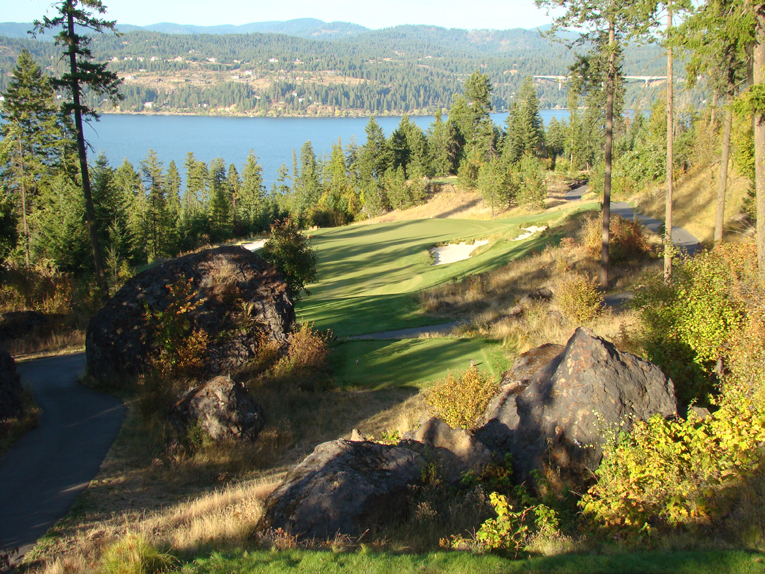
Fazio left nothing to chance with this downhiller; every golfer understands where he is. Compare this to the frustration at some UK links where the golfer’s water views are blocked by large dunes.
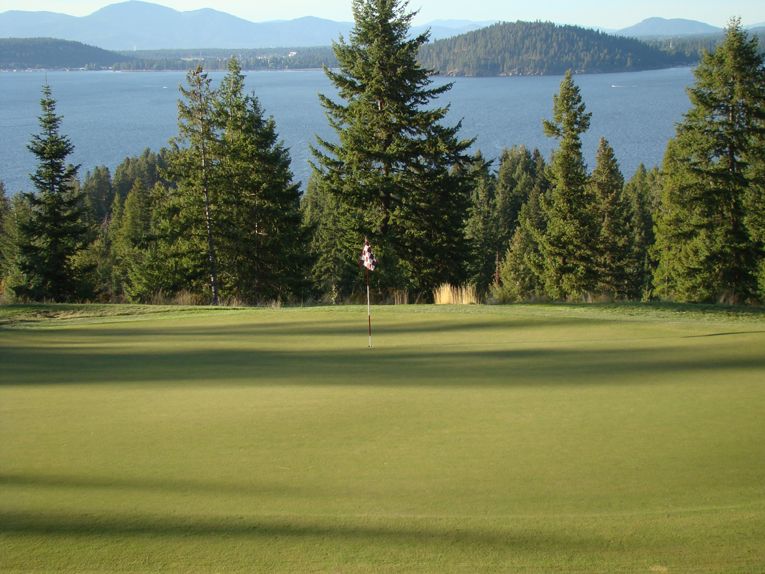
This side view hints at the elusive, long narrow green. What the photograph REALLY shows is the majestic environment.
Fifth hole, 425 yards; There are plenty of occasions where one wants to whip out his iPhone 6 and take a photo as he tours the property. This isn’t necessarily one yet the author welcomes quiet moments like this, no gimmicks just solid golf that reflects the property. At the green, a waste bunker on the left stops a good 40 yards from the front of the putting surface. Meanwhile, the fairway seamlessly bleeds into the green, leaving all shot options open to each player. Such ground hugging features don’t distract the golfer’s eye from his surrounds.
Seventh hole, 175 yards; To build a course like this is expensive. The key is to do it right the first time and not saddle future members with ongoing expenses. While real estate sales foot the bill, the course occupies the best that the property has to offer. A quick view through the photos in this profile confirms that. Yet, there are always trade-offs and one one came here. Beside the sixth hole was impenetrable basalt rock while farther right was a cliff line supremely suited for lots with (multi!) million dollar views. The land plan won and the golf moved more inland. So, what to do with the rock? Serendipitously, as Fazio mulled over his options, it became apparent that more rock would be required for the base of the long entrance road. Case closed! The rock was disintegrated and this sunken hole created.
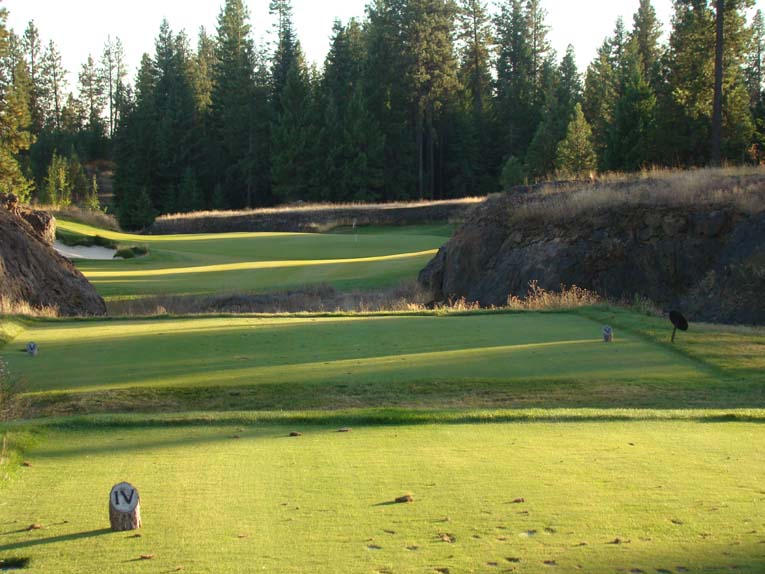
Far and away the most manufactured hole on the property, the author thinks that Fazio pulled it off with aplomb. A drainage slot was even created at the rear through the rock as a safety measure for the occasional freak storm.
Eighth hole, 530 yards; In stark contrast to the last, this might be the most natural hole on the course. Mcphilomy appreciates how little earth was disturbed in building it. A few tee pads, bunkers cut into the natural side slope, a green pad and that’s it. The rest of the hole is at grade, resting peacefully upon the ground. The eighth is also versatile. It can play as a fine three shotter at 605yd but from the forward tee becomes a half par that can be reached in two. Either way, the golfer needs to get past the well placed central bunker in two to achieve the desired outcome.

In compiling Fazio’s eclectic best eighteen holes (there are nearly 4,000 holes from which to choose), Gozzer possesses several of them, including this one.
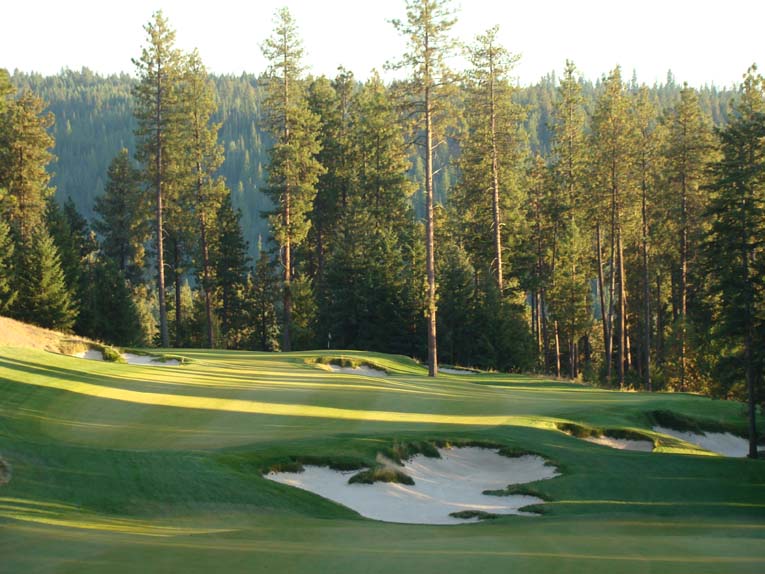
The massive bunker that bisects the lower and upper fairways is – shrewdly – in scale with the hole’s grandeur.
Tenth hole, 515 yards; The author has a bias toward uphill holes as hillsides invariably make for the perfect canvas upon which to carve bunkers. Fazio nicely availed himself of such an opportunity on this 1/2 par hole. A good drive crests one hill and affords the golfer the opportunity to reach the green in two.
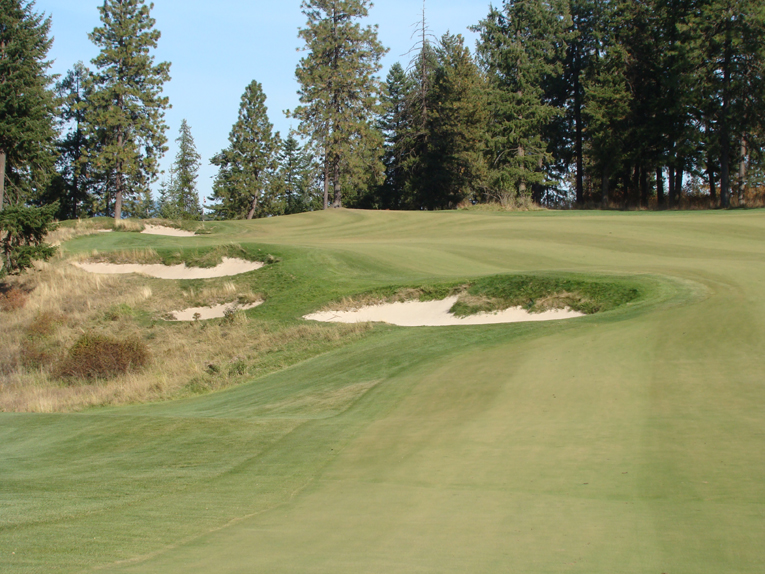
Short grass is maintained well to the right on the high side of the green so that a running draw has a real chance of chasing up the hill and tumbling onto the putting surface. The tawny fairway speaks well of the climate and high quality green keeping.
Eleventh hole, 415 yards; Variety is an underpinning to great golf and it comes in all forms. Ten and eleven at Gozzer highlight getting the mix right. The uphill tenth green with trees behind is followed by the downhill approach to the eleventh with an uninterrupted 3 mile view to the top of Coeur D’Alene Mountain. This constant variation happens throughout the round though the golfer may be blissfully unaware of these seamless occurrences.
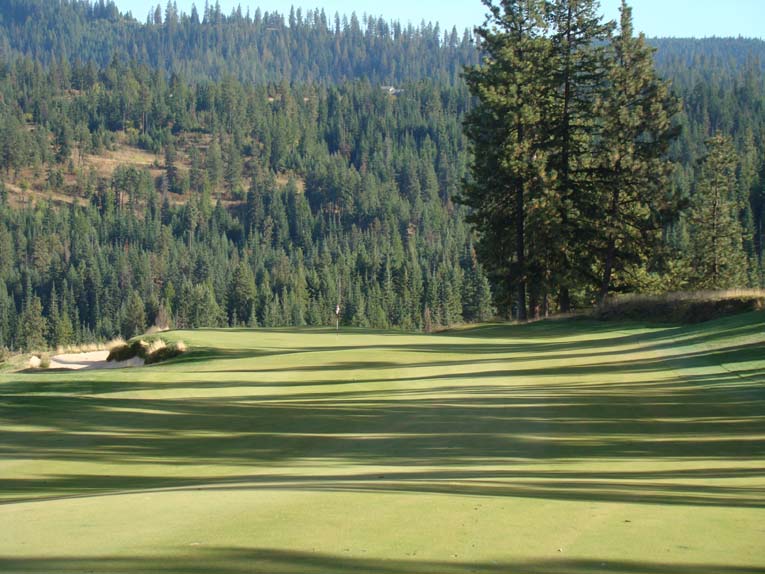
There isn’t a male or female golfer alive of any age who would tire of hitting this approach. The backdrop is exquisite and the golf is too!

Watching one’s approach land short of the green and slowly track across the green toward the hole is mesmerizing. A slight knob in front of the green complicates matters.
Twelfth hole, 315 yards; Every golfer loves an option laden hole, especially one that plays downhill so that a) all available routes to the golfer are highlighted b) he can make the best decision based on the day’s hole location c) he’s emboldened to making a big free swing along the more aggressive path and d) the dramatic results are witnessed from the tee. The key for such a hole to play well over time is that it not favor one playing style over the other. This hole succeeds admirably on that count. The golfer who plays prudently off the tee but possesses a nifty wedge game can fend off the gorilla bomber. A pronounced high left bank along the green serves as a perfect backboard for the golfer who plays safely to the right. Meanwhile, the bomber who comes up just short along the left route faces a ticklish wedge from tight turf to the raised green.
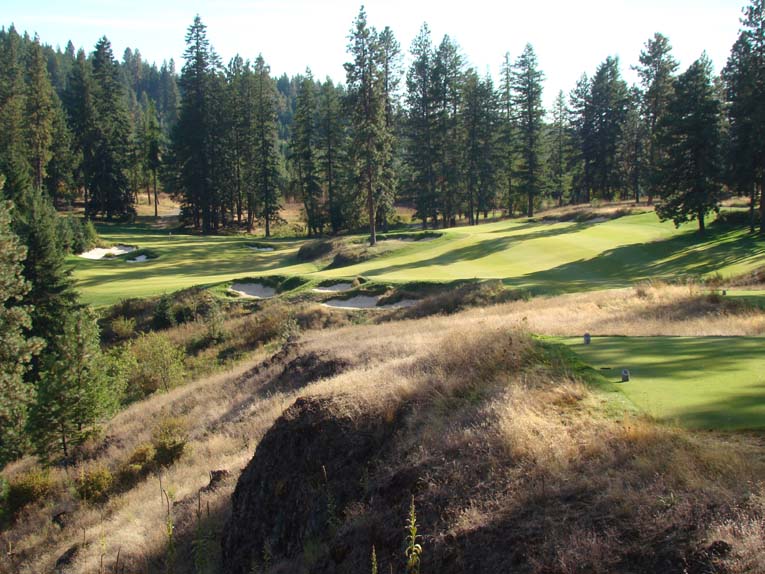
Every golfer’s eyes bulge with anticipation at the prospect of launching a far and true drive. The thinner air found at this elevation of 2450 feet elevation nurtures that greed as the downhill drive enjoys an extra 15 yards of carry. The wistful effort at pulling off (finally!) a heroic drive that can reach the putting surface produces all kinds of scores, from eagles to ‘never mind’.
Fifteenth hole, 405 yards; The name Pacific Northwest conjures up images of vast, unexplored land. A golf course not to the scale of its environs is always a mistake; here, it would have been a tragedy. Happily, that never occurs though it would have been easy. On this hole, a 110 yard wide playing corridor was established in the landing area. The golfer stands on the tee and soaks in the distant mountains and lake. The 58 yard long bunker along the right of the fairway is one of the longest on the course and the 8,450 square feet green is the largest on the course. Everything is in proportion, capped off with the clean lines behind the infinity green.

As seen from two hundred yards out, everything is on a grand scale. Cue the deer on the right in this morning photograph …
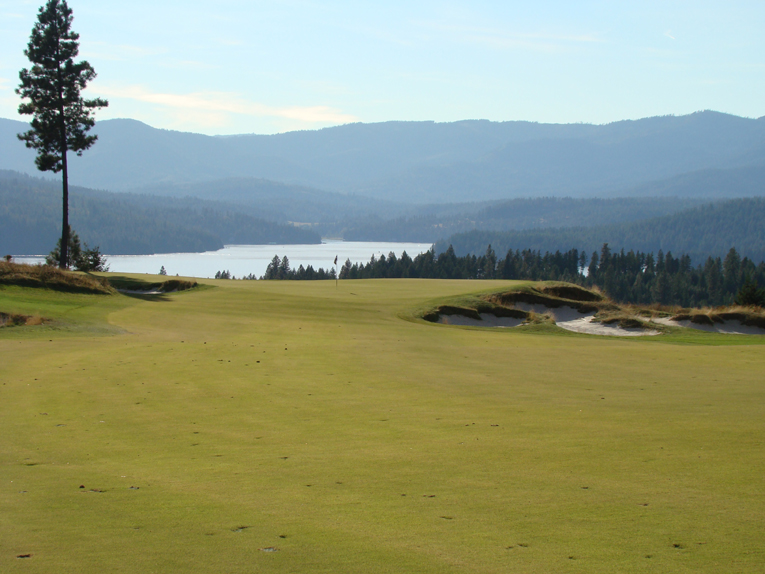
Having the guts to chase after a back hole location and pulling it off creates an indelible moment. The artful infinity green adds to the suspense.
Sixteenth hole, 495 yards; Several members walk the course but there are a couple of abrupt descents/ascents that make the golf cart man’s friend. The descent at the third tee followed by the rise to the fifth and the drop into the sixteenth fairway followed by the steep climb to the seventeenth tee are the most prominent. You have seen the photo of the third and below is the view from the sixteenth tee. In the author’s mind, both of these one-off, dramatic holes along the lake had to be built. A prime draw for members is the chance to see and play something that they cannot find at home (or anywhere else for that matter). Holes like this deliver on that score.
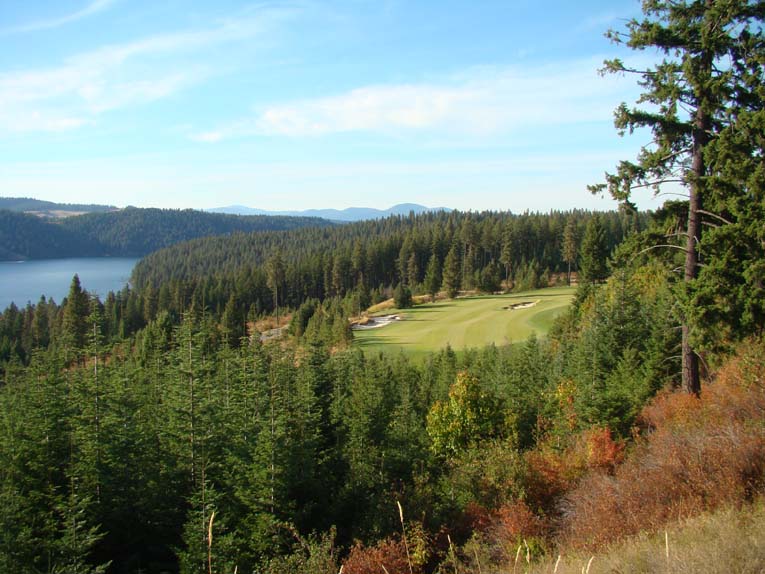
What architect wouldn’t elect to build such a hole?! The sixteenth is both ludicrously gorgeous and strategic with the golfer desirous of getting home in two on this dogleg right needing to slot his drive just right of the central hazard.
Seventeenth hole, 170 yards; Played along the rim of a cliff with mind blowing vistas, this hole was easy to spot in the routing process. The key was to create high quality golf. Thanks to the bold green contours which swing balls left, many a golfer delights in watching his ball slowly but inevitably track from the right middle of the green toward the frequently used lower left hole locations (see photo).

Though it can be hard to focus on the golf, the hole enjoys some Redan like playing characteristics.
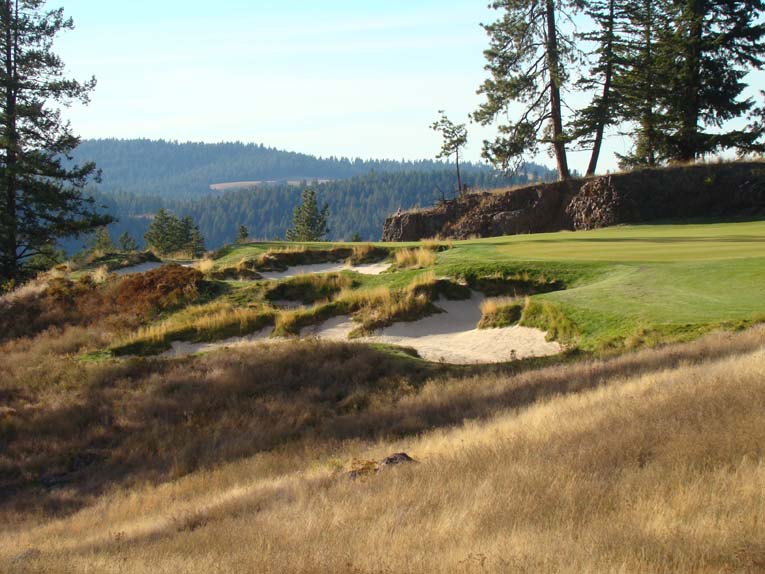
Suffice to say, the texture of the course is superb and greatly adds to the enjoyment of one’s round.
Eighteenth hole, 420 yards; The elevated barn clubhouse with its open fire pits and long views surely portends the prototypical uphill finisher. Wrong! The course gets the finish it deserves with a distinctive closer along the bluff. Once again, ground contours are present to aid the thinking golfer, both on the tee ball and approach.
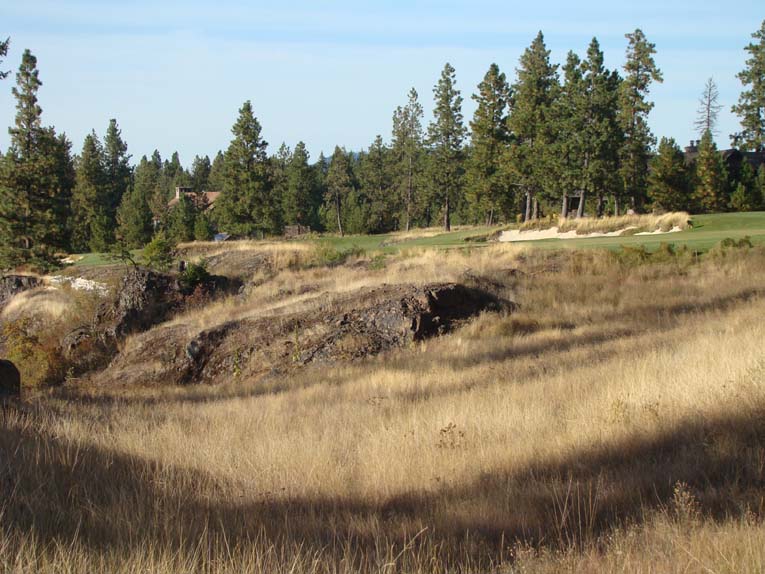
For those that try to stereotype Fazio as never building uphill, blind tee shots, they haven’t played Gozzer Ranch.
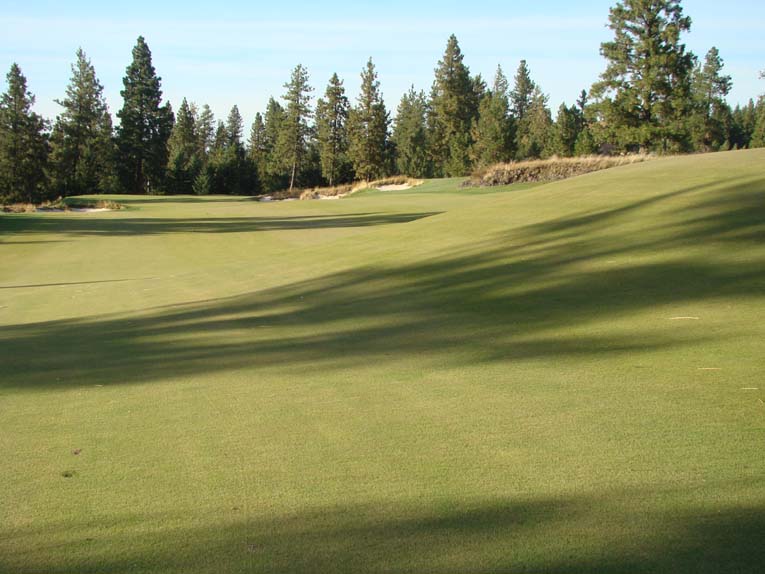
Any tee ball with a whiff of draw takes the contour above and finishes the golfer in the low flat section of the fairway from where a level stance is afforded.
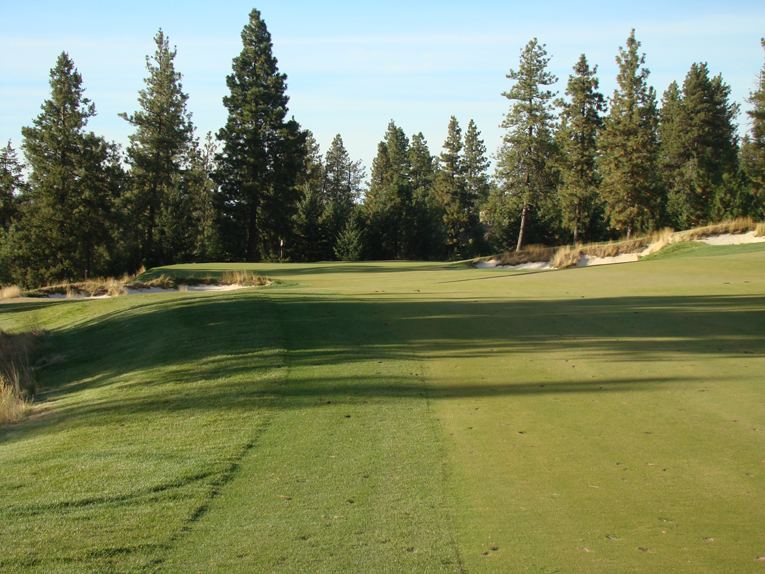
As seen 40 yards shy of the Home green, the play is to utilize the right to left slope of the firm fairway and feed the ball onto the putting surface. The seventy foot bluff looming to the left provides impetus for the golfer to use the land wisely.
Central to forming an opinion on the merits of a course is to understand/gauge its worst holes. After going round the course, the author asked three regulars for their least favorite hole. No immediate response was forthcoming and no consensus was achieved. The most interesting response was the 155 yard fourteenth. When asked why, that person said ‘I feel like I have seen it before.’ Fair enough, but it speaks volumes for the other holes. The fourteenth green is a rare one on the second nine to feed balls left to right so it surely has a place in balancing the shots asked of each golfer.
Tom Fazio, the man who fabricated Shadow Creek from a barren desert, once remarked that money was the one key ingredient to great golf. The author disagrees and places the site’s natural attributes as the most important element. As seen at Gozzer Ranch, these two perspectives on great architecture merge into one. Mother Nature provided a splendid canvas complete with an ideal climate for growing grass. Sandy loam was the sole missing ingredient. Crucially, man brought it in, remedied the situation and created the optimal ground game playing characteristics. Fazio’s routing loops the player around the land, providing a variety of scenic moments. Man’s desire to experience a strong connection with nature is satiated, all while playing great golf. More examples of man employing 21st century construction and greenkeeping techniques to enhance nature will undoubtedly arise but it is hard to imagine a more magical place than here where the Northwest’s dazzling beauty is thrown so vividly into the mix.
Add in the lake house, the crystal clean air and a temperate climate from May to end of October, and you have a retreat of the highest order. John Gozzer would be proud of the rustic result and how people now travel far and wide to enjoy his land. He appreciated as well as anyone: if you are here, life is good.


